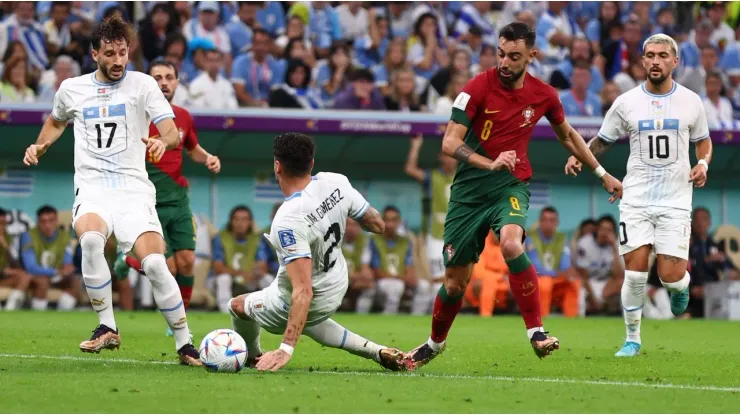The Portugal-Uruguay penalty controversy was one of many talking points out of Monday’s World Cup game, but there were other issues for Uruguay to worry about.
No width and no wits. That pretty much sums up Uruguay’s performance against Portugal in the first 60 minutes.
Despite the security of an experienced three man central defense and a forward line of Edison Cavani and Darwin Núñez to aim for, Uruguay’s wing-backs Matias Olivera and Guillermo Varela were anonymous. Just like Uruguay against South Korea, Uruguay’s threat mostly came from the central areas.
Federico Valverde and Matias Vecino in midfield were outplayed by Bernardo Silva and company. Rodrigo Bentancur was the only Uruguay player threatening to create anything in the first hour. He cut through the Portugal defense like a knife through butter in the first half with an amazing run which he was unlucky did not end with a goal.
Back to 4-3-3
Despite his questionable fashion choice of pairing oversized white trainers with a navy blue suit, there was nothing contentious with Diego Alonso’s substitutions on the hour mark. In came Facundo Pellistri and Giorgian De Arrascaeta as Uruguay moved to a 4-3-3. Finally, balls were being played to the wings (mostly Pellistri’s right wing) and crosses delivered.
Fresh from conceding the first goal, these substitutions galvanized Uruguay. Maxi Gomez rattled the woodwork and Luis Suarez narrowly missed the target from a couple of yards out.
As stoppage time approached, Uruguay were threatening to save a point. At least, until a penalty was given for THAT handball against Jose Gimenez.
Law 12
The International Football Association Board’s (IFAB) take on the handball law as part of Law 12 makes for an interesting read. In fact, a clarification was issued a year ago regarding a handball offense. If a ball touches a player’s hand, it is deemed an offense if the said player “deliberately touches the ball with their hand/arm” and/or “touches the ball with their hand/arm when it has made their body unnaturally bigger.”
I think we can safely say that Gimenez did not touch the ball deliberately with his hand.
Did his hand position make his body unnaturally bigger? Possibly. However, how could Gimenez have prevented the ball from touching his hand? Once sliding for a tackle, it is very difficult to control one’s flailing arms.
World-Cup deja vu
Once such an incident goes to VAR, it is very difficult for the referee to not give a handball. This incident reminded me of Ivan Perisic’s handball offence during the 2018 World Cup Final.
Initially, it seemed the referee was not interested in giving a penalty against Croatia. However, once he made his way to the VAR monitor, you just knew that he was going to point to the spot. Again, Perisic’s handball was not deliberate and it is unlikely that he had control of his flailing arms as he jumped for a header.
Despite IFAB’s 2021 clarification, the handball rule is still as unclear as ever. Saying that it is a handball offense if the arm/hand makes a body unnaturally big is too vague.
Personally, I do think Gimenez caused a handball offense. By touching the ball with his hand and changing its trajectory, he denied Bruno Fernandes a chance to shoot from a decent area. Nothing to do with bodies being unnaturally big!
Ghana are up next for Uruguay. I wonder….did an Uruguayan ever touch the ball deliberately with his hands to deny a goalscoring chance?
My mind boggles.
Photo credit: IMAGO / Sportimage
Guide to World Cup 2022
200+ Channels With Sports & News
- Starting price: $33/mo. for fubo Latino Package
- Watch Premier League, Women’s World Cup, Euro 2024 & Gold Cup
The New Home of MLS
- Price: $14.99/mo. for MLS Season Pass
- Watch every MLS game including playoffs & Leagues Cup
Many Sports & ESPN Originals
- Price: $10.99/mo. (or get ESPN+, Hulu & Disney+ for $14.99/mo.)
- Features Bundesliga, LaLiga, Championship, & FA Cup
2,000+ soccer games per year
- Price: $5.99/mo
- Features Champions League, Serie A, Europa League & Brasileirāo
175 Premier League Games & PL TV
- Starting price: $5.99/mo. for Peacock Premium
- Watch 175 exclusive EPL games per season






